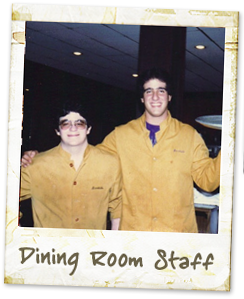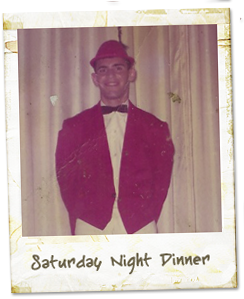Dining Room
 The Dining Room of our hotel was the be all and end all of the hotel. In other parts of the country hotels may have been centered round a lake, a dude ranch, or a golf course, but in the Catskills there was only one way to describe why people came….. “The Dining Room”.
The Dining Room of our hotel was the be all and end all of the hotel. In other parts of the country hotels may have been centered round a lake, a dude ranch, or a golf course, but in the Catskills there was only one way to describe why people came….. “The Dining Room”.
People may have wanted a vacation from the city, but only if it included food. Three meals a day, every day was the standard, and throw in a Smorgashboard on Saturday night.
Being a kosher style resort, all the Jewish dietary laws were followed, such as separate plates and silverware for meat and dairy, no mixing meat [fleishik], or dairy [milkekh] foods at a meal, or serving any foods that were ‘traife’ or not kosher such as pork products, seafood like shrimp and clams. On our menu there wasn’t any ham and eggs, milk with meat, or boiled lobsters in our kitchen or dining room.
Each meal was a production. Breakfast was served over 90 minutes, 8:30-10AM with people coming in whenever they wanted during that time. The choices seemed endless to us doing the serving, and of course no one would write down any orders, everything had to be stored in your head. Training for the future, I guess. There were juices, melons and fruits, any type of egg including omelets, especially the famous LEO….lox eggs and onions. Add pancakes, french toast, lox and herrings, baked herring only on Sunday, hot and cold cereals and of course something sweet to end the meal. On Saturday morning there was no grilling, the kitchen ‘closed’ for the morning so only boiled eggs along with everything else were available.
There were always stories involving the kitchen staff and short order cooks who didn’t show up to cook breakfast. What does one do with guests sitting down to eat without a cook. The answer, get ‘Nate’ and start the grill yourself. I can remember doing the eggs, pancakes, and such myself at times because someone never showed up to work.
Lunch started at 12 noon for the Children’s Dining Room. Once the Day Campers were finished then everything was made ready for the Main Dining Room, where the meal was served at 1PM. The meal was a ‘dairy’ meal, meaning no meat products, but for many years Sunday lunch was a heavy roast beef meal so that guests that were checking out that day had a good meal before leaving. Later the Sunday lunch quietly turned into the same dairy meal as were all the other lunches were.
Behind the scenes the kitchen was a hub of activity from breakfast time through the day making preparations for lunch. All the food, hot and cold was prepared, initially by my Grandma Friedman (in the 40s and 50s), then by Sadie and later by an official ‘cook’. There were many over the years, Minnie, Bertha, Rose, and last of all, Mike the Chef. All were assisted by Sadie, either by helping with the cooking or later by her looking over their shoulders until they made her leave the kitchen until the meal had to be served.
 Lunches started with a juice or fruit cup, and no matter what the juice was some guests had to have another flavor. Then came soup. However, the name of the game was to have alternatives, if you didn’t like pea soup, vegetable or potato soup, have some cold borscht with a boiled potato, or better yet, something directly from the “Old Country” ‘Schav, a type of cold vegetable soup. To me the best description I have ever found for Schav is the following:
Lunches started with a juice or fruit cup, and no matter what the juice was some guests had to have another flavor. Then came soup. However, the name of the game was to have alternatives, if you didn’t like pea soup, vegetable or potato soup, have some cold borscht with a boiled potato, or better yet, something directly from the “Old Country” ‘Schav, a type of cold vegetable soup. To me the best description I have ever found for Schav is the following:
“My father used to drink Schav right out of the jar. It nauseates me now just thinking about it. I recall the taste: a lawn clipping milkshake. Granted, I was probably 10 years old the last time I tasted it, so who knows, I might actually like it now. But still, I shudder just thinking about my father chugging that glass jar of leaves floating in an off-white milky solution.“
The main dish entrées included fish in all varieties, baked, fried, broiled, cold fish, but usually either white fish or red snapper. Some days there was noodle pudding, blintzes, and cooked vegetable plates. But, of course guests could always order a salad dish like tuna fish, chopped eggplant, chopped herring, and smoked white fish, sometimes a bite of strawberries and cream, or chopped vegetables that would be in additional to, not instead of the regular meal in most cases.
Finally there was coffee and cake to finish the meal. Then the final activity of The Brookside, a walk to the nearby bridge on the country road, enough activity to help digest ones food so that they could be ready for dinner that was only 5 hours away.
Dinner was the main meal if one can call it that. Linen table cloths, white during the week, but on weekends fancy changes; Friday night blue table cloths and napkins, Saturday red linens, and Sunday evening Gold was the color of the evening. The cloth napkins were rolled into candlestick shapes and put into the glasses to make the room more festive. In addition, in the 1960s for some reason the waiters and busboys had to dress in white pants and shirts with red jackets. I have no idea why that decision was made, but it was what we did. Dinner during the week was usually fairly quiet, the number of guests was lower as all the husbands were back in New York working and didn’t return until Friday evening.
The meals were similar, start with melon or grapefruit, an appetizer, soup and then a main dish. Usually there was a rhythm to the week. Monday calves liver, Tuesday veal cutlet, Wednesday meat loaf or Salisbury steak, Thursday Corned beef and cabbage, Friday chicken and pot roast, Saturday steak and Sunday roast beef. Of course there always was flanken, a boiled beef, for those who didn’t want chicken.
Sometimes waiters who weren’t familiar with the menus could get confused. One weekend a waiter walked into the kitchen with a puzzled look on his face asking Nate if there was a show that night because people were asking him about Chollie and Franklin. His version of ‘challah’ and flanken.
The roast beef meal was always a problem. There were never enough ‘end cuts’ for all the guests that requested them, many of the guests felt that the hotel had special roast beef, all made of end cuts.
The other problem was that the meat was too rare or too well done. One could make roast beef more well done, you just dropped it into the big heated bowl of gravy and waited a few minutes, but trying to make roast beef rarer was a bigger trick. Nate would sometimes try to ladle some ‘au jus’ gravy over well done meat to make it appear as if it was rare, but that really didn’t fool anyone. The waiters just tried to switch plates around on the tray and give a guest one that looked a little rarer than the slice you had tried to serve them. It was the best one could do.
Again there was dessert, cake or pie and always a few cookies just in case the cake wasn’t enough. There was also the most famous Catskill dessert ‘Forlata’; or as we knew it ‘for later’.
In the very beginning my grandfather did have a ‘professional waiter’ Morris Halpern who had worked in restaurants in New York City and came to work at the hotel as a combination waiter and salad man. But usually the staff were ‘boys’, there were no girls in the dining room until the 1960s, working to earn money for college. It was a way to pay the bills while having a summer of fun away from the city. Usually the waiters and busboys were relatives, sons of guests or family. Everyone was eager to become a waiter because the tips were so good. Lots of people started working as a bell hop or children’s dining room busboy and ‘graduated’ to the main dining room and finished their ‘Catskill career as a waiter.

Brookside Recipes
Brookside Recipes
Awesome! I have photos from the 70’s and 80’s … would love to share!
Lauren